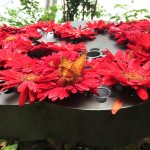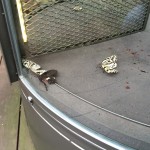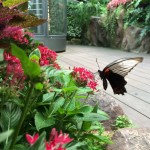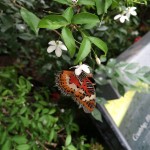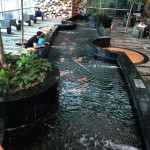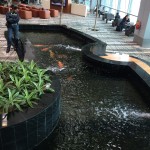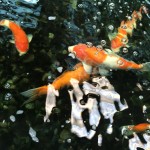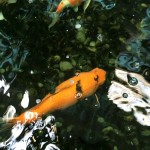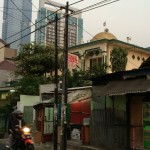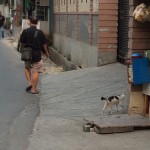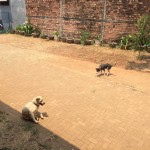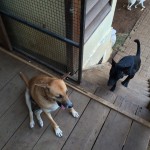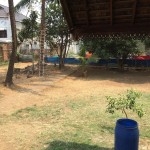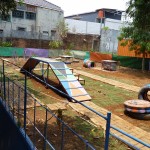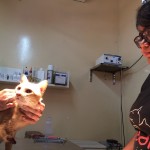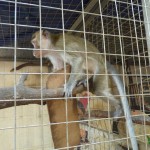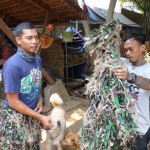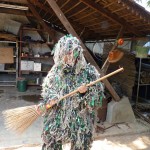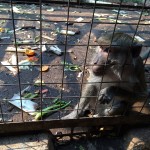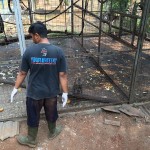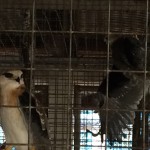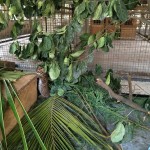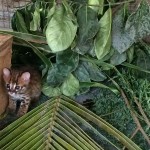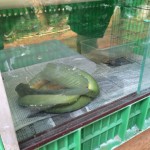Since 2001, Animal People has co-sponsored the Asia for Animals conference. This year, the AfA is to be held in Kuching, Malaysia from October 6-10 (learn more). During the two weeks beforehand, Animal People executive director Wolf Gordon Clifton is traveling in Indonesia to visit different animal welfare-related projects. This series of articles, “Archipelago Animal Adventures,” is intended as a travelogue to document what he’s seen, for the benefit of activists in Indonesia and across the world striving to improve animal welfare in the archipelago.
Unless otherwise marked, all photos are free to use for non-commercial purposes, as specified under CC BY-NC 4.0.
___
Day One: Thursday, September 24th
The day began in Singapore’s Changi Airport. After checking out of the airport transit hotel, where I had managed to obtain a few hours’ bedrest after a full day of air travel (12 hours from Seattle to Shanghai, about 6 hours’ layover, then another 4 1/2 hours to Singapore), I had just enough time before my flight to Jakarta to check out the airport’s butterfly garden and koi pond.
- The butterfly garden
- The butterfly garden
- Waterfall
- Butterfly feeding station
- Butterfly feeding station
- Emergence cage, where insects mature from pupae to adult butterflies
- Butterflies emerging from their pupae
- Freshly hatched butterflies, not yet able to fly
- Butterfly feeding on nectar
- Butterfly with wings outspread
- Feeding butterfly
- Information panel on the design of the garden
Studies have shown that honeybees can navigate using landmarks, communicate through body language, and even use abstract thought to learn patterns of symbols, colors, and smells, as documented in Jeremy Narby’s superb Intelligence in Nature. Others have identified signs of pain and suffering in insect relatives such as spiders, crabs, prawns, and lobsters. I personally believe that insects, like vertebrate animals, are sentient, can suffer, and deserve moral consideration, despite the low regard in which they’re held even by animal activists. I was pleased that the butterfly garden seemed to account for animal welfare in its design, with curved walls and no sharp corners so as to minimize insect death, and offerings of fresh fruit to supplement their diets.
- Koi pond from bridge
- Koi pond from bridge, other side
- Koi underwater
- Koi underwater
- Koi underwater
- Information panel
There had been a koi pond when I last passed through the Singapore airport, many years prior, but if my memory is correct it had been quite different in design. I seem to recall it being overall more circular in shape, with floating lily pads (probably synthetic). Compared to the new, redesigned pond, I think this would have provided more space and a less sterile environment for the fish – which, like insects, have been shown to intelligent and sensitive (with certain species demonstrating pain, using tools, and forming complex social structures) despite the low regard they are paid by most people, activists included.
__
Aboard my flight from Singapore to Jakarta, I steeled my emotions in preparation to witness bloodshed; for of all days I could have chosen to arrive, I had inadvertently picked the Eid al-Adha, a Muslim holiday and the largest ritual slaughter of animals in the world. The Eid al-Adha celebrates the prophet Abraham’s willingness to sacrifice his son Ishmael, only for God to substitute a ram at the last moment. Now once a year, many Muslims commemorate Abraham’s test of faith by slaughtering animals themselves – often in very crude, brutal ways far from the relatively humane standards of halal slaughter prescribed in the Qur’an.
I didn’t realize I was scheduled to arrive on the Eid until I told my friend Anita Mayangpuspa, herself a Jakarta resident and animal lover, about my travel plans. She told me she was planning to leave the country that day to escape the carnage. Though initially horrified at the prospect of witnessing animals killed and butchered in the streets, I decided that since my mission was to see firsthand the state of animal rights in the archipelago, I should make the most of my arrival date and document what I saw of the Eid al-Adha with photographs and firsthand description, for the future benefit of animal activists.
To my surprise, I didn’t see any animals slaughtered during the 30-minute taxi ride from the airport to my hotel. Anita had advised me that the actual killing mostly occurred in the morning – whereas I left the airport around 2:00 PM – and that it wouldn’t be as visible from the main roads. Nonetheless, we passed enough side roads and residential areas that I still would have expected to see blood left on the streets or carcasses being butchered, as I had some years prior in India when I arrived just after that year’s Eid al-Adha slaughter.
After settling in to my hotel, I decided to take a walk to see what I could observe of the Eid on foot. It was no surprise that the hotel’s upscale immediate surroundings, catering heavily to tourists, were free of visible bloodshed. So I kept walking until I was far away from the hotel; through multiple busy shopping malls, past mosques and Islamic schools, into residential neighborhoods with no large businesses and no obvious foreigners besides myself.
- Jakarta mosque
- Street scene a couple miles from the hotel
- Jakarta mosque
- Residential area
- Residential area
- Street cat
- Street cat
- Bold street cat about to cross a busy road
- The boldest cat of all, rubbing on my leg
People were generally quite friendly, with many smiling, saying hello, or honking their motorcycle horns at me (a gesture which, as I learned in previous trips to Indonesia, has a far more gracious meaning than in the United States). I saw about a dozen cats, most apparently stray, though four of them were clustered around someone’s front porch alongside a free-roaming chicken, strongly implying they were pets instead. All of them were remarkably bold. One cat walked up to rub my leg when I stooped to photograph him; another strolled non-chalantly across a busy thoroughfare, passing within feet of pedestrians and moving vehicles without hardly changing her pace. It would seem as though none of these cats had ever had any negative experience with humans.
Besides the cats and one chicken, the only other animals I saw were lizards, darting nervously up and down the walls of buildings (earlier, during the taxi ride, I also briefly observed two thin carriage horses). As for the Eid al-Adha, during my entire two hour round trip walk, I saw only a single clear sign of the slaughter: a banner advertisement for a service delivering animals to people’s homes.
How could such a huge, violent holiday leave so little evidence in its wake? Even after walking an hour into fully residential neighborhoods, was I still too close to the touristy commercial areas? Was this district disproportionately Christian, Buddhist, or Hindu in demographics? Or are Jakarta residents simply very fastidious in their practice of the Eid, performing the slaughter and then cleaning up immediately afterward?
I hoped that meeting with local animal activists in the days to come would provide some clarity.
___
Day Two: Friday, September 25th
In arranging the Jakarta leg of my journey in Indonesia, I had communicated mostly with Femke den Haas, one of the co-founders of Jakarta Animal Aid Network. Femke was presently in Bali and would be unable to meet with me herself, but had arranged a busy itinerary for me, beginning with a visit to JAAN’s headquarters. I had made sure to book my hotel, The Grove Suites, relatively close to the JAAN center. Even so, the drive took a solid 40 minutes through Jakarta’s narrow, crowded streets. The driver, Pak Luki, remarked that the traffic was actually less than usual, since many city residents were still away on vacation for the Eid.
My first impression of the JAAN center was that it was very clean and not overcrowded, both unusual qualities for animal shelters in developing countries. Most of the dogs freely roamed the center’s grounds, with only a few confined to smaller enclosures, either due to behavior problems or to illnesses requiring separation from other animals. I was also impressed by the doggie playground, constructed by volunteers to provide a source of enrichment.
- Dogs near the front gate
- Most of the dogs were inside to escape the heat
- JAAN center courtyard
- JAAN center courtyard
- Dog kept separate due to behavior problems
- Dogs in separate enclosure
- Dog in separate enclosure
- Pit bull previously used as a guard dog, kept separate due to safety risk
- Doggie playground! Built entirely by volunteers.
Perhaps I shouldn’t have been so surprised at the manageable number of dogs at the JAAN center, given that dogs appeared to be uncommon in Jakarta. So far I had not seen any roaming outside the center. Indeed, the majority of dogs under JAAN’s care were either abandoned pets or had been rescued from dog meat dealers, after being imported from other parts of Indonesia. Most were available for adoption.
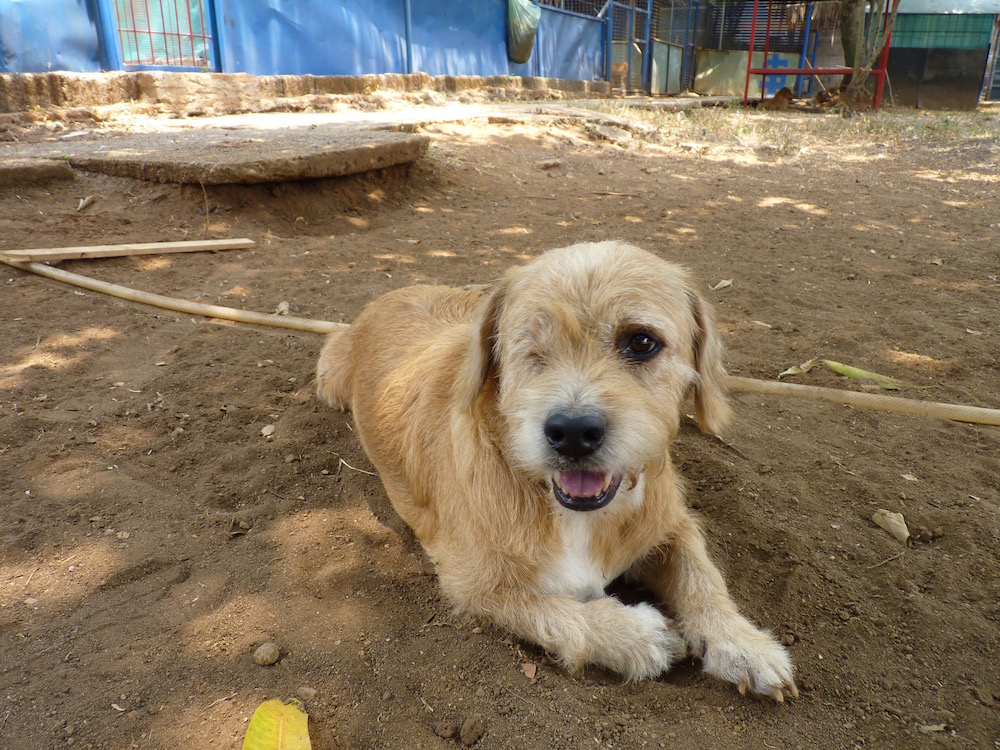
This little one-eyed dog was a victim of deliberate cruelty, but now resides happily at the JAAN center awaiting his forever home.
JAAN staff and volunteers, including veterinarian Mariana Ferdinandez, “Dr. Merry,” and Nadia, an aspiring veterinarian studying in Germany, showed me around the facilities. There was a quarantine area for incoming dogs, though apparently it had security problems since some of the other dogs could climb over the fence (yes, Indonesian dogs can climb like cats!). I suggested installing a “lip” at the top of the fence that would extend diagonally, preventing anyone from getting over the top, much as we use at home on Whidbey Island, Washington to keep our cats from escaping the backyard. At first I was concerned about the sanitation of the open air preparatory room, which I mistook for the operation room, but was relieved to see that the actual operation room was indoor and air-conditioned.
- Quarantine area
- The quarantine area’s surprisingly climbable wall
- Dr. Merry and friend
- The open air prep room
- Prep room bed
- A cat brought in with a missing leg, inside the operation room
- Dr. Merry examining the cat. Probably the cat will need surgery to remove what’s left of her injured leg.
- Nadia talks with another volunteer in the prep room, while Dr. Merry works behind them
- Staff and volunteers at the JAAN center
In addition to domestic animals, JAAN also works with wildlife. Wildlife trafficking is a huge problem in Indonesia, with animals being captured from the wild and sold in markets to keep as pets, status symbols, or use for food or medicine. Monkeys are often confiscated from dealers in government raids, but there is limited space to hold them, and a complex government bureaucracy that often greatly delays efforts to rehabilitate them.
At the time of my visit, JAAN had one monkey in residence at the center, waiting to transfer to the much larger Cikananga Rescue Center (which I would visit a few days later) for rehabilitation and, hopefully, release back into the wild. I also saw volunteers trying on a military camouflage outfit, in preparation to rescue an injured monkey loose outside the city.
- Juvenine monkey at JAAN center
- Monkey
- Monkey
- Volunteers try on camouflage suit
- Posing in camouflage
There seems to be a lot of comraderie among the JAAN team, who not only work together to save animals, but also participate in fun bonding activities together, such as dancing:
Over lunch, Dr. Merry told me about a spectacular animal welfare victory she’d had just the previous day. The Jakarta government had pledged to better manage the city’s street dogs, and proposed to build a new animal shelter as a solution. Dr. Merry, representing JAAN, had met with them to argue that a new shelter was not the answer, since shelters simply fill to capacity without significantly impacting the total population. Instead, she proposed that the city’s funds would be better spend on a mobile spay/neuter clinic, with microchipping for each dog to keep track of how many had been sterilized and in what areas. The city readily accepted JAAN’s idea, and asked them to draft a formal proposal for next week! I was highly impressed by JAAN’s success in influencing the government, and the huge win for animal welfare it represented, but also found it encouraging that the Jakarta government’s initial strategy for dealing with the dogs had been a shelter – rather than simply massacring them as is currently being done in Bali and northern Malaysia.
I also learned of another major victory JAAN had achieved back in 2013. At the time, many of the wild-caught monkeys brought into Jakarta were used as dancing monkeys, forced to entertain and perform tricks under constant threat of physical punishment. JAAN petitioned the city government to intercede, and the city responded. Not only were dancing monkeys banned within the city limits, granting the police authority to confiscate them and arrest their abusers, but the city’s governor, Joko Widodo (now President of Indonesia), personally attended the first monkey rescue to great publicity and fanfare. I was almost envious – when was the last time President Obama participated in an animal rescue operation?
Dr. Merry spoke highly of Joko Widodo in other ways as well, praising him for cracking down on corruption in Indonesia’s government, and for cleaning up Jakarta’s streets and waterways of pollution. Indeed, Jakarta was far cleaner than it had been during my last visit six years prior. At the time, the city had been almost unbelievably polluted, littered in garbage and choked in a toxic haze of stench. Now it was like a totally different place, with relatively little garbage (for a large city in a developing country) and air pollution no worse than in many U.S. cities.
I asked about the Eid al-Adha, explaining what I had seen (or rather, not seen) the previous day. Dr. Merry was slightly surprised I hadn’t seen any evidence of it besides the advertising banner, but explained that in general, Indonesian Muslims are very fastidious in their practice of the Eid. Animals are only slaughtered on the grounds of mosques, and when their throats are cut the blood is drained into holes in the ground and then buried. The bodies are immediately butchered and the meat cooked and distributed, and the entire process is finished by about 1 PM. Arriving as I did after 2:00, there wouldn’t have been much left for me to see. This was very different from the Eid al-Adha as I had seen it practiced in Egypt and India, where the animals are slaughtered in the open and the streets remain littered with bodies, freshly butchered meat, and pools of blood for days afterward.
I wondered if the much greater emphasis on cleanliness in Indonesian Islam might correspond to a higher standard of animal welfare, with the animals treated more gently and slaughtered more humanely, in accord with the Qur’an’s stipulations? It seems to me that this would be a worthy question for research.
___
After lunch, we visited a government facility where a large number of rescued monkeys, as well as some birds of prey, a couple wildcat kittens, and a starving python being nursed back to health, were being held.
- Monkeys lined up in one of the cages
- Monkey
- Monkey climbing
- Monkey
- Worker inspecting the monkeys
- Birds of prey
- Birds of prey
- Wild cat kittens’ enclosure
- Wild cat kitten
- An emaciated python, just recently rescued
- Preparing food for the monkeys
The welfare standards were not ideal, with the monkeys crowded in rather small enclosures and the birds of prey kept in the dark under a wooden roof, with minimal space to fly. However, JAAN is limited in how much it can do here. JAAN has a large wildlife rescue and rehabilitation center of its own, the afore-mentioned Cikananga site, and partners with several other organizations with similar facilities, but can’t take rescued animals there until they’ve cleared all the levels of government bureaucracy (including, in some cases, the need to present animals as evidence in prosecuting wildlife traffickers). There is also limited space at the proper wildlife facilities, creating a backlog of animals waiting to be transferred in.
In the mean time, the government provides housing for the animals, but JAAN has to foot the bill for everything else they need, including food and medical attention. I was told of the many upgrades JAAN would make to the facilities if they had full control over the operation. In the mean time, the animals are at least much better off than they would be in the hands of traffickers, and can look forward to much better care and, hopefully, an eventual return to their native habitat.
Overall, my first two days in Jakarta left me feeling very hopeful for Indonesia’s future. The country faces innumerable animal welfare crises: the wildlife trafficking epidemic, the massacre of dogs in Bali, the cruel dog meat trade, ritual slaughters such as the Eid al-Adha and Hindu and animist sacrifices, abysmal zoos and aquariums, and more. Yet the emergence of powerful figures in government who care about animals – or, more cynically, at least feel enough pressure from their citizens to pretend they do – is a highly encouraging sign, and may provide a powerful source of support for activists to use in combating the country’s problems.
It seems the winds of change have arrived in Indonesia.
Continued in:
Escape From Raptor Island: Archipelago Animal Adventures, Day 3
Night of the Fire Face: Archipelago Animal Adventures, Days 4-5






